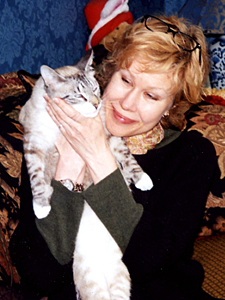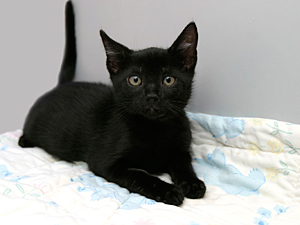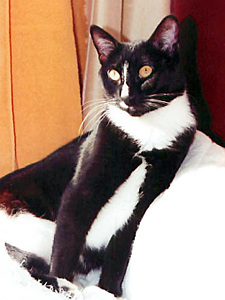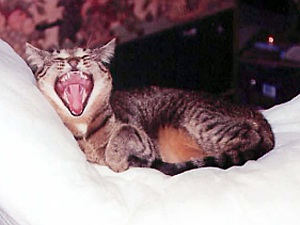
Deborah Chieglis provides two valuable volunteer services — providing foster care and sewing cage comforters.
Volunteer Spotlight: Deborah Chieglis Fills Two Unique Volunteer Needs
Editor's note: More than two years ago, Deborah Chieglis was a featured volunteer in Out of the Cage! Because of her special volunteer contributions to NYC's homeless animals, we decided to feature Deborah again in an updated article, and also highlight the fact that instructions for creating cage comforters are now available to everyone who visits the Mayor's Alliance website. Please take a look!
Deborah Chieglis spends her days dealing with law firms, accountants, advisors, and due diligence issues. She is a consultant in the financial services industry, handling marketing, sales, and content development for conferences. But Deborah's true passion is animals, and it's embodied in her volunteer pursuits — creating cage comforters and fostering back to health weak and injured cats and kittens.
Cage comforters are small quilts that are placed in the cages of animals awaiting adoption from shelters or rescue groups. The comforters provide the animals with a more cozy and comfortable environment, and help reduce the animals' stress of being in a cage. They also allow potential adopters to more easily envision the animals as part of their homes and lives.
Deborah began sewing cage comforters more than two years ago while she was grieving the loss of her 18-year-old black "meezer," Taj, to cancer. A few months after Taj's death, Deborah visited the Animal Care & Control (AC&C) shelter on East 110th Street to "take a look" at the cats. Feeling that it was too soon to adopt, she decided instead to volunteer at the shelter, doing adoption education and kennel cleaning. When she discovered that volunteers at AC&C's Brooklyn shelter were sewing cage comforters for the animals, she was inspired to try it. "I went home and cannibalized an old comforter, and when I brought the little comforters up to the Manhattan shelter, I saw almost immediately that the animals' stress level went down as they settled into the comforter," she remembers.

Homemade cage comforters make a shelter cage more comfortable, and they can help to increase an animal's chances of adoption.
Since then, Deborah estimates that she has created roughly 150 comforters. She says it's hard to keep track, focusing less on numbers and more on diminishing the piles of donated sheets and comforters she has in her apartment. "I have notices in my building welcoming donations of fabric and linens from my co-op," she says. "As an added result I've become the 'go-to' person in my building for any pet behavioral or adoption issues."
During the week Deborah makes time to work on the comforters. She brings some of them to the Mayor's Alliance, which in turn donates them to City Critters, KittyKind, AC&C, and other groups. And sometimes Deborah takes comforters directly to AC&C. To see the cage comforters in use, stop by PETCO at Union Square, where KittyKind shows cats for adoption, or PETCO in Turtle Bay, where City Critters cats are available.
To inspire more people to get involved in making cage comforters, the Mayor's Alliance posted Deborah's easy "how-to" instructions on our website. The Alliance also has arranged for Deborah to teach a cage comforter class for seniors through a program of the Jewish Association of Services for the Aged (JASA).
She advises: "You want to make sure they are pretty non-destructible," she says. "That means that tiny claws and paws won't ruin them immediately. Stay away from looped fabric and fabric that pulls easily. The best material is fleece. Some of the cats and kittens pull and suck on the fabric as if they are nursing!"

Tokyo was Deborah's first "three-legger" foster cat.
And that brings us to Deborah's other volunteer endeavor: fostering "three-leggers," as she affectionately calls them. These are cats that have come into the shelter system with severe fractures but are otherwise adoptable, she explains. "Thanks to the Picasso Veterinary Fund, these cats have received medical treatment. I have fostered three amputees so far, and am now on my fourth."
Deborah's first "three-legger" foster cat was Tokyo, who, about a year ago, had a bad rear-leg fracture. Tokyo was taken to Fifth Avenue Veterinary Specialists, the specialty veterinary hospital in Chelsea that has treated dozens of Picasso Veterinary Fund animals for the Mayor's Alliance, where a splint was applied to the leg. Following the procedure, Tokyo was placed in an adoption program with an Alliance Participating Organization (APO). But her rear leg became stiff (not an unusual occurrence with this type of injury), so she was returned to Deborah for physical therapy. After trying many different forms of physical therapy and consulting with a veterinary surgeon, it was decided that it was in Tokyo's best interest to amputate the leg and thereby improve her mobility. Deborah cared for Tokyo throughout her recovery, up until she was adopted into a permanent home.
Describing her fosters, who range in age from one to two years, Deborah says, "They recuperate fairly quickly. It's amazing how resilient they are! Very soon they are jumping onto the bed (with a little help from a step stool), the couch, and relaxing in the sunshine in front of my living room window."
"When I tell people about the fostering I do," Deborah says, "they almost always say, 'How can you do that? How can you let them go after you nurse them back to health?' I view myself as a half-way house — a midpoint in the animal's life — so that they can easily transition into their forever home. While I would love to keep each and every one of them, it's more important that I can help a potential adopter get a well-balanced and loving cat."

Deborah's "permanent foster" cat, Puppy, plays social director for her other cats.
Deborah does have one foster who never left — and so has become her foster helper. "She's a tiny tiger who was abandoned on the street, malnourished, covered in fleas and cooking oil. While she is a little girl, she plays an important role in helping the fosters adapt to new situations. Also, she has been seen teaching them where all the best toys are hidden in the house!"
Deborah says she learned her commitment and love of animals from her mother, who lives in Upstate New York. Recently her mom rescued a mom-cat and litter of kittens from the countryside.
"I did not, however, inherit my sewing skills from her. She is a Seamstress Extraordinaire and I am a humble but diligent beginner who managed to break a sewing machine already." But never mind that. Deborah says that cutting and sewing the cage comforters is great therapy and a good source of relaxation for her. "To see the animals cuddling in them at the shelters and adoption centers is the ultimate payoff."
To learn how you can create cage comforters for shelter animals, check out Deborah's instructions. If you and a group of friends or colleagues want to find out how to make sewing cage comforters a fun and useful group activity, please contact the Mayor's Alliance at info@AnimalAllianceNYC.org.






